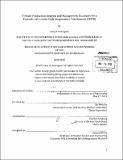| dc.contributor.advisor | Lin-Wen Hu. | en_US |
| dc.contributor.author | Rodriguez, Judy N | en_US |
| dc.contributor.other | Massachusetts Institute of Technology. Department of Nuclear Science and Engineering. | en_US |
| dc.date.accessioned | 2013-11-18T19:24:33Z | |
| dc.date.available | 2013-11-18T19:24:33Z | |
| dc.date.issued | 2013 | en_US |
| dc.identifier.uri | http://hdl.handle.net/1721.1/82449 | |
| dc.description | Thesis (S.B.)--Massachusetts Institute of Technology, Dept. of Nuclear Science and Engineering, 2013. | en_US |
| dc.description | Cataloged from PDF version of thesis. | en_US |
| dc.description | Includes bibliographical references (pages 37-38). | en_US |
| dc.description.abstract | The Fluoride-salt-cooled High-temperature Test Reactor (FHTR) is a test reactor concept that aims to demonstrate the neutronics, thermal-hydraulics, materials, tritium management, and to address other reactor operational and maintenance issues before a commercial Fluoride-salt-cooled High-temperature Reactor (FHR) can be deployed. The MIT Nuclear Systems Design class proposed a design for a 100 MW FHTR that uses enriched- 7Li flibe (Li2BeF4), has both thermal and fast flux testing positions for fuel and materials testing, and provides a neutron flux greater than 3E14 n/cm2 -s for accelerated irradiation testing. One of the key technical issues of the FHR and FHTR is tritium generation from the flibe coolant and its radiological control. The objectives of this study are: 1) to provide an overview of tritium production in various types of nuclear systems, 2) to estimate the tritium source term in the FHTR using the ORIGEN-S computer code, and 3) to propose a tritium management strategy for the FHTR. A review of existing nuclear systems shows that tritium is the primary radionuclide in liquid and gaseous tritium release. Light water reactors release up to several hundred curies per year for which various tritium removal and control strategies have been developed and implemented. Using the ORIGEN-S code analysis, tritium production for the MIT FHTR design at 20 MW is estimated to be about 2600 Ci per year (based on a 70% capacity factor and-10 Ci/day), with 99.99% enriched- 7Li flibe. Using this source term, a tritium removal rate of >90% is proposed as a design target for the tritium control system of the FHTR in order to maintain tritium release within the limits of existing nuclear reactors. Proposed tritium management strategies for the FHTR include increasing the 7Li enrichment, carbon-based or metallic getters, and inert gas sparging with a high-temperature recombiner system. | en_US |
| dc.description.statementofresponsibility | by Judy N. Rodriguez. | en_US |
| dc.format.extent | 41 pages | en_US |
| dc.language.iso | eng | en_US |
| dc.publisher | Massachusetts Institute of Technology | en_US |
| dc.rights | M.I.T. theses are protected by
copyright. They may be viewed from this source for any purpose, but
reproduction or distribution in any format is prohibited without written
permission. See provided URL for inquiries about permission. | en_US |
| dc.rights.uri | http://dspace.mit.edu/handle/1721.1/7582 | en_US |
| dc.subject | Nuclear Science and Engineering. | en_US |
| dc.title | Tritium production analysis and management strategies for a Fluoride-salt-cooled high-temperature test reactor (FHTR) | en_US |
| dc.type | Thesis | en_US |
| dc.description.degree | S.B. | en_US |
| dc.contributor.department | Massachusetts Institute of Technology. Department of Nuclear Science and Engineering | |
| dc.identifier.oclc | 863050914 | en_US |
